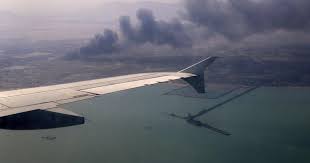
Satellite images have revealed the extent of the devastation caused by an explosion at Iran’s Shahid Rajaei port near Bandar Abbas, which resulted in at least 46 deaths and over 1,000 injuries. The blast, which occurred on Saturday, has left the area severely damaged, and the fire that followed the explosion was still burning on Monday, two days after the initial incident.
The images, provided by Planet Labs PBC and analyzed by The Associated Press, show extensive destruction, including two large craters roughly 50 meters (165 feet) in diameter. Several buildings around the blast site were completely destroyed, with one building reduced to rubble and another heavily damaged. Containers nearby appeared twisted and distorted by the force of the explosion.
The explosion has raised numerous questions, particularly about its cause. Local news outlets have speculated that the blast may have been linked to the port’s receipt of chemicals needed to produce solid fuel for ballistic missiles. However, Iranian authorities have denied these reports, offering no clear explanation for the source of the explosion’s power. The Iranian military has also denied receiving shipments of missile fuel chemicals, despite claims from private security firm Ambrey, which reported that ammonium perchlorate had been delivered to the port from China earlier this year.
Ammonium perchlorate is a chemical compound used to produce solid propellants for rockets, and the shipment was allegedly intended to replenish Iran’s missile stockpiles. These stocks had been depleted during Iran’s direct involvement in attacks on Israel during the war between Hamas and Israel in Gaza.
The explosion’s aftermath has been chillingly reminiscent of the 2020 Beirut port explosion, with social media videos showing reddish smoke rising from the fire just before the detonation, a sign that a chemical compound might have been involved in the blast.
Iran’s semiofficial news agencies reported that statements about the cargo that caused the explosion had been “false” and that the shipment had been delivered without proper documentation or tags. Saeed Jafari, CEO of a marine services company operating at the port, said that the lack of documentation and the false statements about the cargo were “very dangerous.” He also mentioned that only high-ranking officials, including members of the Iranian Revolutionary Guard, could bypass the normal procedures at the port.
The explosion occurred amid heightened tensions over Iran’s nuclear program, which was the subject of negotiations with the United States. While authorities have yet to offer a definitive cause for the explosion, the incident has further fueled speculation about the nature of the chemicals at the port and the potential military implications.
As authorities continue to investigate the cause of the explosion, the port remains a focal point of concern, with ongoing fires and questions about how the disaster unfolded. The international community is watching closely, given the sensitive nature of the cargo and the political tensions surrounding Iran’s missile program and its nuclear ambitions.
Sources By Agencies


